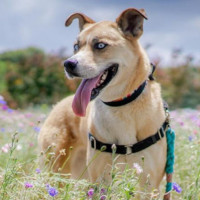Appearance of the Boxsky
|
| The Boxsky closely resembles the Boxer in appearance. This dog's body can vary from medium to large. Its stance is one of vigilance and curiosity. Often brown-eyed, the breed can inherit the piercing blue eyes of the Siberian Husky. Its short to medium coat tends to vary between tan, fawn and white with black. The coat is also known to take on a denser feel, common to the Siberian Husky, and is water repellent. Ears can be erect or floppy. The tail tends to be full but with a short coat. The Boxsky's weight varies from 16 to 34 kilos and it stands 51 to 89 centimeters tall. Each specific dog may vary according to litter, size, weight and appearance. |
Temperament of the Boxsky
|
| Boxsky energy levels are considered very high due to Siberian Husky traits. As a dog that will bounce off walls if not given attention, this highly energetic breed craves constant exercise. This hyperactive canine breed likes to be active and expects its family to engage it constantly. The Boxsky can be hesitant around strangers if not trained early. The Siberian Husky parent is a cautious dog that protects its family. The Boxsky is no different and can serve as an exceptional guard dog, early training will help this breed tell the difference between a friendly stranger and an intruder. This motivated dog is ideal for families, but not for young children, as its exuberance can be too much for them to handle. This is an incredibly vocal breed that will need consistent but firm instructions on how to effectively reduce the frequency of barking. The Boxsky will need to be socialized as a puppy to be friendly with other dogs as well as other animals. Although intelligent, this breed will benefit from positive reinforcement and rewards such as treats. |
Needs and activities of the Boxsky
|
| The Boxsky naturally has a very high energy level that needs to be handled by an experienced dog owner. Not a dog for beginners, the recommended exercise session for a Boxsky should last between 70 and 80 minutes a day, sometimes more. Multiple long walks a day are highly recommended, in addition to intense play. This is not a dog to be left to his own devices all day long. Apartment living is not recommended, as this breed needs space to run and expend its energy. Your Boxsky is known to be an escape artist, so be careful if you have a fenced yard, don't leave him unattended to dig or skip his way in search of adventure. An ideal environment for the Boxsky would be a large house with a large fenced yard in a cool climate. |
Maintenance of the Boxsky
|
| The Boxsky is not considered a hypoallergenic breed and sheds a lot. This breed is not recommended for allergy sufferers due to constant coat rashes. Daily brushing with a curry rubber brush will help remove much of the dead hair. A smoother brush and a de-shedding tool will come in handy when shedding is at its most intense. Not a swimmer, this hybrid won't need to be bathed often. Teeth should be brushed at least two or three times a week, and nails should not be neglected. Check them often for tears or cracks. Ears may have wax build-up. What's more, if your Boxsky loves water, make sure you dry his ears thoroughly after a swim. |









 English (United Kingdom)
English (United Kingdom)